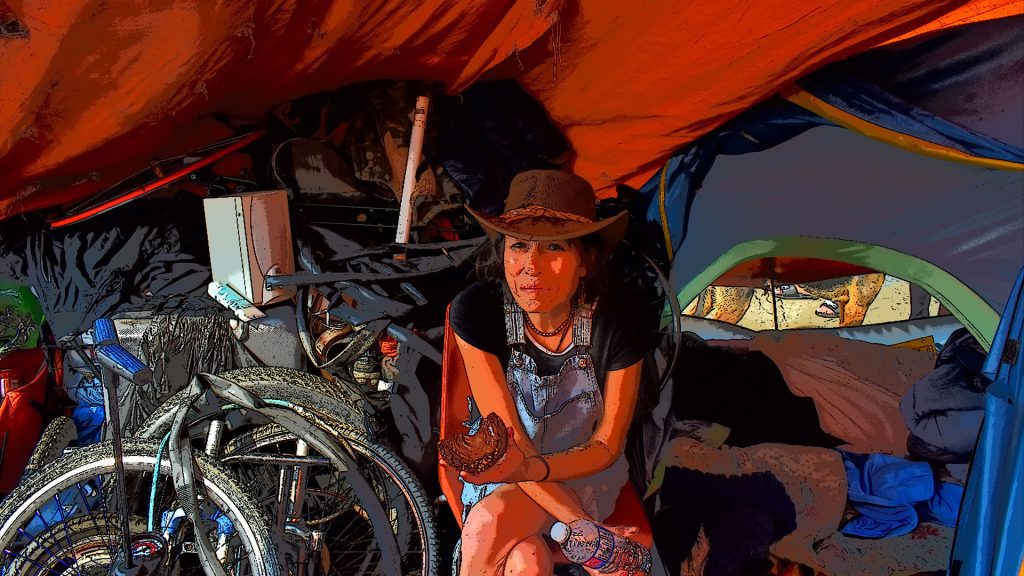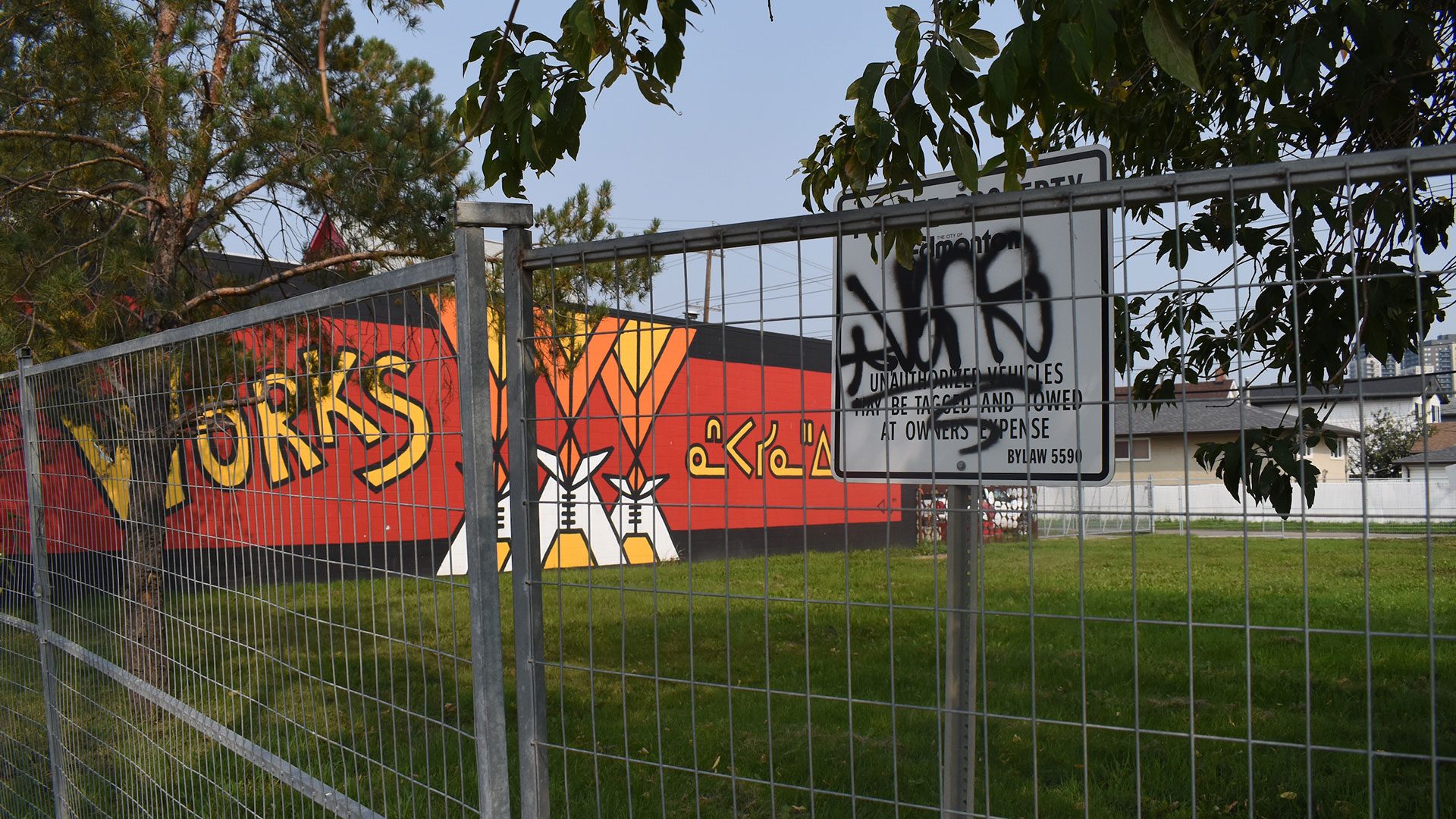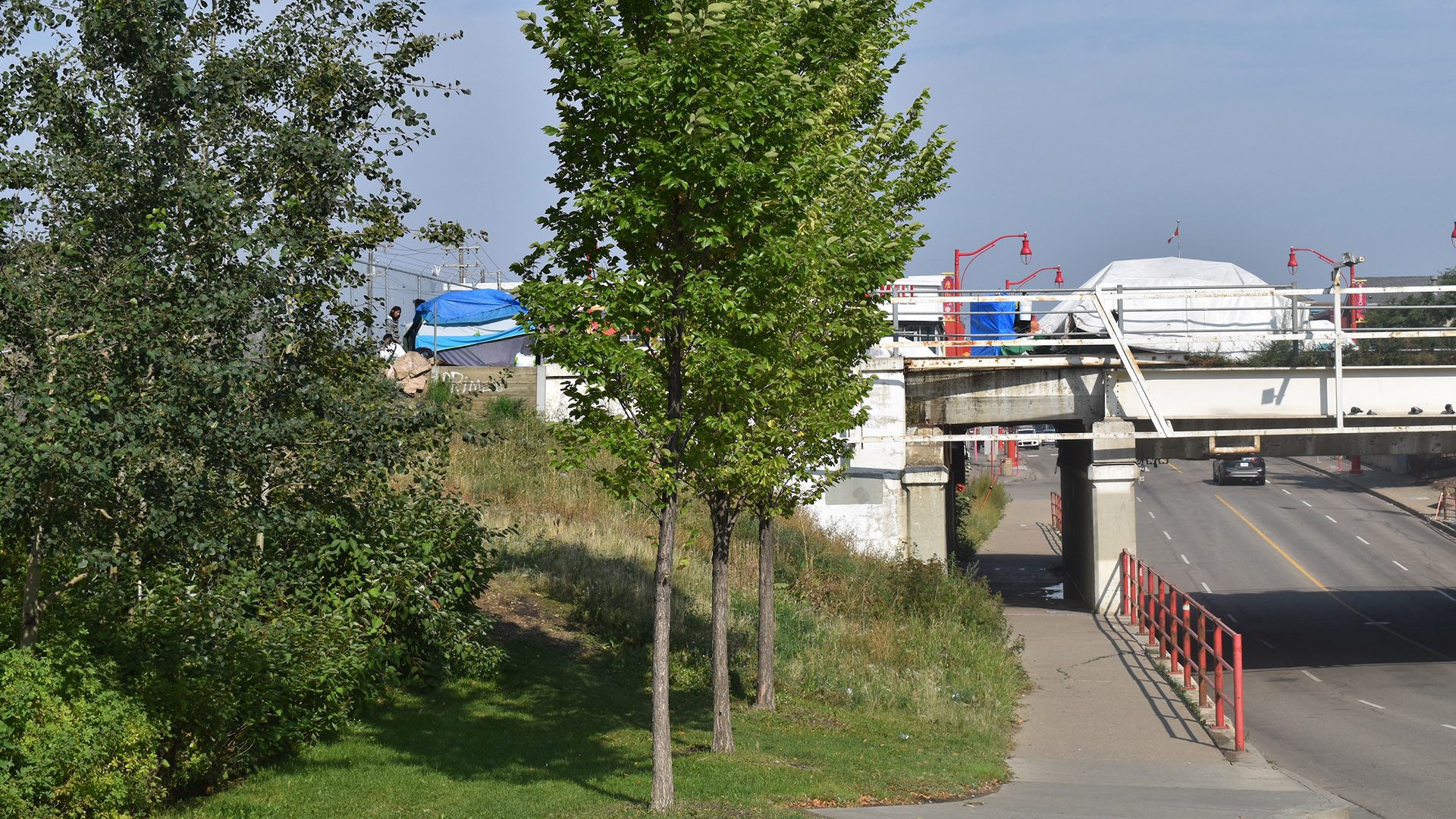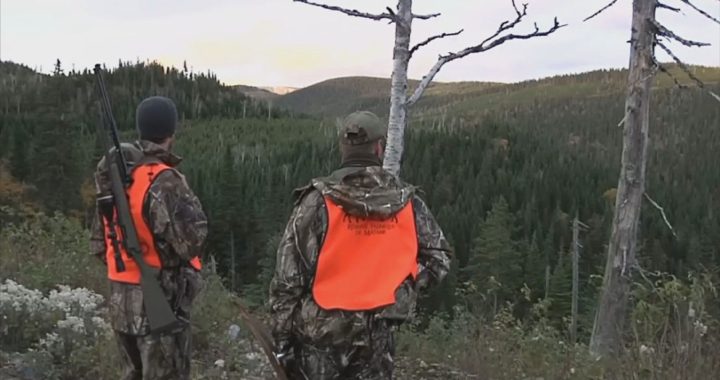
Cheyenne eats a cookie under an orange tarp. Photo: Danielle Paradis/APTN
Encampment residents ride in and out on bicycles near a collection of tents and tarps that has sprung up by an inner-city bottle depot in Edmonton.
The tarps are bright orange and blue. The tents form a loose circle in a gravel parking lot, against a backdrop of Edmonton office towers.
There’s an inflatable pool for kids who stop in to visit their grandfather who lives in the encampment.
APTN News went with Judith Gale from the Bear Clan Beaver Hills house to visit three encampments where people have been living to talk to them about their experiences with being unhoused.
Bear Clan provides supplies and food to people who are unhoused.
“People act like I was born into homelessness like I didn’t make $80,000 last year,” said Tyler Kamahkoostayo. Kamahkoostayo is Indigenous.
He told APTN he ended up houseless after a bad relationship and family troubles with a partner and his mom and sister.

He is now the Quasar Bottle Depot encampment’s official bike mechanic. Bike parts fill the encampment–uncountable numbers of wheels and frames and parts are set up under tarps.
Chopper, a shiny-coated German Shepard is sitting at the entrance to the circle of tents. He comes up warily to greet the arriving vehicles and rejects the offer of a peanut butter sandwich.
“That is how I found my way into homelessness,” said Kamahkoostayo about his family conflict.
The term ‘homeless’ has fallen out of favour with advocates for affordable or transitional housing.
“We want to change terminology because we are all born with a house. Our body, our vessel that we come onto this star with is our home,” Gale said.
She calls the notion of homelessness a “colonial mindset.”

Kamahkoostayo agrees with Gale about the importance of changing the language.
“This place feels more like home to me than when I lived in a house,” he said.
This is a situation which is growing more common and the reasons are as varied as the people who spoke to APTN.
Some have a relationship breakdown; others with criminal records or old injuries find finding and keeping work difficult. Some struggle with addiction or the organization required to have and maintain a place to live.
All the people we spoke to long for a place where they can come home, whatever form it takes.
But, the number of people without shelter is growing. According to data from Homeward Trust, a non-profit that keeps track of the number of people identifying as unhoused, the number has grown from 1,114 in 1999 to 3,008 in 2023. This rivals a previous peak during the 2008 global financial crisis where the number climbed to 3079.
In 2023, 56 per cent of unhoused people identify as Indigenous.
Edmonton is one of many places where encampments have received major news coverage.
It is the day after there was an announcement in front of city hall that an advocacy group was suing the city for their clearing of encampments.

The lawsuit, filed Aug. 28, is not seeking damages but, instead, looking for a permanent injunction to prevent the city from continuing encampment removals and a statement saying that the people whose property has been removed had their charter rights breached.
Read more:
City of Edmonton slapped with lawsuit over encampment removals
A city report from May notes that according to Homeward Trust’s By Name List, there were between 2,650 and 2,800 Edmontonians experiencing homelessness last winter.
During that season, there were 1,202 emergency shelter spaces funded by the provincial government, 627 permanent and 575 temporary and up to 150 funded by the city.
Bicycle shop started with a trade
“I make my livelihood building bikes and making trades. I started trading with a single bus ticket,” said Kamahkoostayo.
He and others in the camp told APTN they don’t steal the bicycle parts but work with found parts and donations and that police regularly check the area.
“You find parts in the river valley… or people who have accumulated a bunch of parts in their apartment building,” said Kamahkoostayo.
APTN is not able to verify this information one way or the other.
“I would need an investigative file number(s) to properly research a potential incident and/or any trends occurring in the camps,” said Scott Pattison, Edmonton Police Service spokesperson in regards to questions about whether police check the encampments regularly for stolen bicycles.
APTN was also told it would take “several weeks” to get back data on stolen bikes in the city by EPS.
However, EPS did provide a statement regarding their participation in dealing with encampments.
“The EPS primarily provides support with high-risk encampments, focusing heavily on the safety of vulnerable individuals, the community, residences and businesses,” said Pattison.
He said there are “very real safety concerns associated with encampments and high levels of victimization that occur within them.”

Moving downtown
Kamahkoostayo said that originally he was staying close to his mother’s house and eating food out of dumpsters but he moved downtown because that is where there were services for unhoused people.
“Kids come and play in the pool here, we have a few families. We gave them bikes but they got destroyed,” said a woman who only gave her first name, Cheyenne.
Cheyenne said that this encampment doesn’t want people who are doing drugs to move in.
“People want to move in, especially people who are doing down [Opioids] and we don’t let people do that here,” said Cheyenne.
Community and police conflict

Another encampment is perched on the edge of the Edmonton River valley. It sits nestled, somewhat ironically behind two large signs from the city of Edmonton that reads “affordable housing.”
It is a small camp, with four or so tents and tarps spread out through sparse trees. It is right beside a busy road into the river valley and the sound of traffic is loud during the day. Only a few people are sitting around when APTN arrived.
Roy Cardinal, who lives in the encampment, is standing beside a bike with a makeshift trailer. He is preparing to help someone move her belongings to the encampment.
“We get a lot of pushing around by these police officers… the last event they came into the camp and for some reason pulled us all out and said us we weren’t supposed to be here,” said Cardinal.
“As I was sitting there I was cuffed. I am 260 lbs and 6’4 and the other big guys were cuffed,” said Cardinal.
He admitted to APTN that he did have a criminal record but said on that day the police were looking for someone else.
“But they gave us all the shakedown,” he said.
When asked about the police procedures for encampment checks, their spokesperson did not provide specifics but responded with a general statement about working with the city.
“Our efforts are focused on community safety and specifically the levels of violence and crime that are often perpetuated within and on the individuals residing in encampments,” said Pattison.
City Response
Aaron Paquette, a city councillor who is also the only Indigenous member on council, had an uncle who died living in the streets.
The issue is personal to him.

Paquette recalls the last time he saw his uncle. He was on the street asking for spare change. When he recognized his nephew, he asked him to go for a walk.
“We went to the legislature grounds. He went to a tree and said, ‘I like this tree’. He sat down, and it wrapped him like a hug,” said Paquette.
He watched as his uncle fell asleep. He said his uncle had trauma related to being indoors, and he was happiest outside.
“When I looked at his face, I saw him like a child. I tucked his money cup into his pocket and left him to rest,” he said.

Paquette walked downtown with this reporter as we discussed encampments and the city policy.
As the city is now faced with a lawsuit there’s been a reluctance from city administration to answer questions related to their encampment plan.
Paquette could not comment on some of the aspects of encampments, but he agreed to speak about encampments generally, the root causes, and who is responsible for funding.
As he crossed the street during the interview, an impatient bus driver turning a hasty left issued a loud horn blast. Paquette, who just stepped onto the curb, watched the bus go by with a slight smile.
“This is one of my favourite things about being a city councillor. No one knows who you are, so you get to see the real city,” he said.
The Edmonton city councillor noted that affordable housing has become an issue in most large cities in Canada.
“It’s obvious in Canada and the United States, we are seeing an increase in mental health and addiction challenges… drugs are more dangerous and far more addictive,” said Paquette.
In 2023, Statistics Canada estimated that an average of 235,000 people in Canada experience one of the many types of homelessness each year. This includes living without any sort of shelter, using emergency shelters, or being provisionally sheltered such as living with a friend or relative.
According to 2021 data from Statistics Canada, three per cent of the Canadian population aged 15 years and older, about 842,000 people, lived in subsidized housing.
“Women were more likely than men to live in subsidized housing: three per cent of women lived in subsidized housing compared with two per cent of men,” said a report from Statistics Canada.

Across Canada, the housing issue has taken different forms from displaced residents to a lack of affordable options. But community encampments are acting as the grss roots solution.
A building closure in Winnipeg’s east end has caused displaced residents to seek shelter with Manitoba Housing or remain in unhoused encampments. The Adanac Apartments were ordered closed on Aug. 21.
In July 2023, an encampment at Regina City Hall was forcibly closed one Friday evening when police swept through the encampment, dispersing residents and arresting 11 people after a fire destroyed a tent, according to local news reports.
City Administration response
APTN also reached out to city administration regarding an April 2023 “Enhanced Encampment Response” plan that listed five goals for the city response to encampments, including “improving communication and reporting on outcomes and progress” and “increase the number of people housed from encampments”
They responded that they would answer the questions in December after the “Enhanced encampment response plan” went to the community and public services committee.

The response in its entirety read:
“A Council Report that will follow up with the Enhanced Encampment Response Plan is scheduled to go before the Community and Public Services Committee on December 4, 2023. It is called CS02001 Enhanced Encampment Response Plan Update. We would be happy to answer your specific questions about encampments and the initiatives related to them at that time.
A Council Report entitled CS01881 Enhanced Encampment and Unsheltered Homelessness Response Plan – Recommended Next Steps is scheduled to go before the Community and Public Services Committee on October 30. This report will speak to the next steps in developing Indigenous-led transitional spaces. We would be happy to answer your questions at that time.”
Paquette has pushed forward the idea of an Indigenous-led response to affordable housing and encampment management.
“The idea is that you don’t just have folks in tents. You have enough units for people so they can actually stay in a warm, dry place,” said Paquette.
Paquette told APTN it will take a while to get the initiative up and running partly because the province is now interested in a similar model.
“We are just not investing in mental health and that is not a city responsibility that is health care. It’s just like as a city we don’t create and fund a military. We don’t have the money for it and we don’t have the legal authority,” he said.
Cardinal told APTN he wants the ability for small groups to form communities without constant displacement from city officials and police.
There are people in the camp who he has been helping to quit opioid use, and he believes stability is an important part of recovery.
“I’ve lived in the streets a long time…the little mishaps we have here are a lot better than what is going on at some other camps,” he said.










